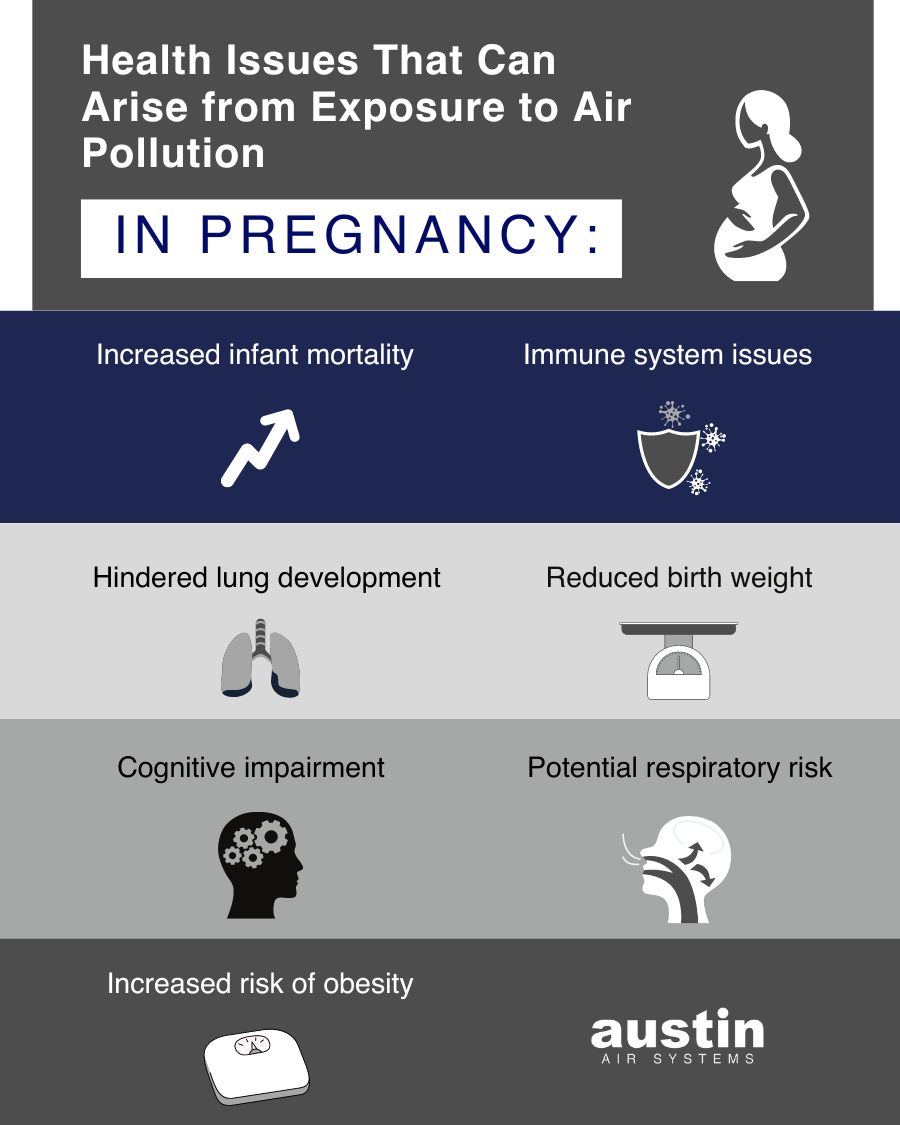Are you thinking of having children? Or perhaps you’re hoping some grandchildren will come into your life? The journey of pregnancy is an exciting and transformative time in a family, marked by a myriad of joys and anticipation. It is also a time of careful consideration for both the mother and her unborn child.
There is a flurry of preparations to be made and lots of new health-conscious concerns. Things that are generally harmless, like caffeine, sushi, and hot tubs, become hazards. Although most soon-to-be moms probably enjoy a break from heavy lifting or changing the kitty litter, some of the other requirements during pregnancy may be challenging.
One often overlooked yet critical factor is the quality of the air we breathe. While air pollution is a concern for all, its impact is amplified on expectant mothers and their developing babies.
In the last decade, a consistent stream of research has shed light on the profound impacts of air quality on pregnancy outcomes. In this blog post, we delve into the most recent study of air quality concerns for pregnant women and the respiratory health of newborns. We’ll also review practical steps to help you get through pregnancy safely.
Previous Research on Air Pollution Exposure During Pregnancy
We’ve known for decades that certain things, like cigarette smoke, are bad for growing babies. But the first research establishing a correlation between environmental pollution and birth defects wasn’t published until recently – in 2008. This first discovery was based on observations of wildlife that are incidentally exposed in nature.1 Since then, there has been a flurry of research examining the impact of pollution on pregnancy outcomes.
Exposure to air pollution during pregnancy has been demonstrated to have different adverse effects on various birth outcomes.2 These include:
- Reduced birth weight
- Disruptions to immune system development
- Hindered lung development
- Increased infant mortality
- Higher likelihood of respiratory ailments later in life
- Cognitive impairment3
- Increased risk of obesity4
The worst imaginable outcome – infant mortality – is also increased. New research published last month in the journal Environmental Health Perspectives has added to the evidence that air pollution exposure in the womb can lead to outcomes that are long-lasting and sometimes tragic.
Prenatal Exposure to Air Pollution and Respiratory Distress in Newborns
The leading cause of illness and death of newborns is respiratory distress.5 It is defined as underdeveloped lungs, characterized by breathing difficulty in newborns that deprives organs of oxygen. It impacts roughly 7% of newborns. Treatments include systemic antibiotics, assisted ventilation, and oxygen therapy.
The scientific community had previously accepted that exposure to air pollution is associated with respiratory issues later in life – including a link to asthma and conditions like Chronic Obstructive Pulmonary Disease (COPD) – but the researchers wanted to explore the impact of air pollution on newborns specifically.
The concern isn’t simply about the distress itself. The treatments of oxygen therapy and assisted ventilation can also lead to long-term respiratory problems, despite improvements to the techniques.
To investigate the issue, researchers analyzed a group of 2,000 pregnant women from 10 different Canadian cities. The expectant mothers were recruited during the first trimester. The levels of exposure to common pollutants, including fine particulate matter (PM2.5) and nitrogen dioxide (NO2), were calculated using a variety of tactics like ground-level monitoring, land-use regression, and satellite-derived models.
PM2.5 is one of the most common outdoor and indoor air pollutants. It’s fine, inhalable particles that are small enough to embed in lung tissue and cause damage throughout the body. There are natural sources like dust and soot, but also human-made byproducts of industrial processes.6
NO2 is a gas that is released into the atmosphere by the burning of fossil fuels. It reduces respiratory function and causes inflammation in the lungs.7 NO2 also contributes to PM2.5 levels.
Although higher exposure rates were not linked to formal diagnoses of respiratory distress, the increased exposure to PM2.5 led to a higher need for different clinical interventions, including assisted ventilation and systemic antibiotics. Higher rates of NO2 exposure also required additional use of systemic antibiotics.
Alarmingly, these results applied to all the periods studied – including prepregnancy.
How to Stay Safe
There is consensus among researchers that it is crucially important for ambient air pollution to be reduced. Government agencies are attempting to do so worldwide, but the mitigation efforts have a long way to go. Additionally, there is now evidence that the more intense wildfire seasons are reversing improvements made to air quality thanks to initiatives like the Clean Air Act. Therefore, experts also advise expectant mothers to be mindful of air quality.
If you are expecting, it is crucial to consider air quality to protect your unborn baby. If you plan to become pregnant, these are also practices that you should adopt now to ensure the best health for your baby.
But you’re probably thinking – avoiding air pollution isn’t as simple as steering clear of deli meats or unpasteurized dairy products. This is true, but there are steps you can take to protect yourself.
- Watch the Air Quality Index (AQI) and stay indoors if necessary: AQI is often listed in many weather apps nowadays. You can also follow the status of the AQI in your area by checking out AirNow. It’s a website run by the Environmental Protection Agency with organizations in every state, plus NASA and the USDA Forest Service. When air quality is low, stay indoors. If you must spend time outdoors, limit your activities as much as possible.
- Keep away from secondhand smoke and vapes: Smoking indoors is taboo in many places throughout the country, but there is a sizable population of people who vape inside without a second thought. Avoid exposure to either of these!
- Avoid Volatile Organic Compounds (VOCs): Be careful with the fumes from cleaning supplies, glues, etc. Maybe you’re painting a nursery and buying new baby furniture? Get it as far before the baby’s arrival as possible to allow for as much off-gassing as possible.
- Ditch artificial scents: Many beauty products and perfumes use artificial fragrances that are toxic. This also includes air fresheners and many scented candles. Opt for natural essential oils instead.
- Get an air purifier: The Austin Air HealthMate Plus has the most robust air cleaning technology on the market – with up to 15 pounds of activated carbon and true medical-grade HEPA which capture 99% of contaminants up to 0.01 microns in size (like PM2.5). It also has potassium iodide-impregnated carbon specifically targeted to remove contaminants such as formaldehyde, which off-gas from flooring and new furniture.
An added benefit is that all of the above will help everyone in the home to be healthy and strong before, during, and after pregnancy.
REFERENCES
1 Guillette LJ, & Edwards TM. Environmental influences on fertility: can we learn lessons from studies of wildlife? Fert and Ster. (2008, February 1) 89(2),e21-e24. doi: 10.1016/j.fertnstert.2007.12.019.
2 Proietti E, Röösli M, Frey U, Latzin P. Air pollution during pregnancy and neonatal outcome: a review. J Aerosol Med Pulm Drug Deliv. (2012, August 2) 26(1):9-23. doi: 10.1089/jamp.2011.0932.
3 Yi C, Wang Q, Qu Y, Niu J, et al. In-utero exposure to air pollution and early-life neural development and cognition. Ecotox and Envi Safety. (2022, June 15) 238,113589. doi: 10.1016/j.ecoenv.2022.113589.
4 Patterson WB, Glasson J, Naik N, et al. Prenatal exposure to ambient air pollutants and early infant growth and adiposity in the Southern California Mother’s Milk Study. Environ Health (2021, June 5) 20,67 doi: 10.1186/s12940-021-00753-8.
5 Johnson M, Mazur L, Fisher M, et al. Prenatal Exposure to Air Pollution and Respiratory Distress in Term Newborns: Results from the MIREC Prospective Pregnancy Cohort, Envi Health Per, 132, 1, (2024, January 2024) 132,1. doi: 10.1289/EHP12880.
6 Particulate Matter (PM) Basics (2023, July 11). US EPA. https://www.epa.gov/pm-pollution/particulate-matter-pm-basics.
7 Nitrogen Dioxide. (2023, October 26.). American Lung Association. https://www.lung.org/clean-air/outdoors/what-makes-air-unhealthy/nitrogen-dioxide.


